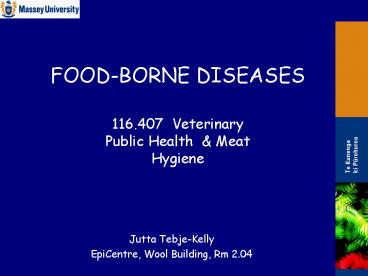FOODBORNE DISEASES - PowerPoint PPT Presentation
1 / 29
Title:
FOODBORNE DISEASES
Description:
Causes of food-borne diseases/illnesses: Chemical toxins ( residues' ... Food-borne disease outbreaks & food spoilage. Contamination with undesirable micro-organisms ... – PowerPoint PPT presentation
Number of Views:5449
Avg rating:5.0/5.0
Title: FOODBORNE DISEASES
1
FOOD-BORNE DISEASES
116.407 Veterinary Public Health Meat Hygiene
- Jutta Tebje-Kelly
- EpiCentre, Wool Building, Rm 2.04
2
Introduction
- Causes of food-borne diseases/illnesses
- Chemical toxins (residues)
- Biotoxins endotoxins exotoxins
- Infectious agents exogenous endogenous
(zoonoses)
3
Introduction contd
- endotoxins exotoxins
- lipopolysaccharide (LPS) protein
- part of bacterium extracellular
- no toxoid toxoid
- low potency high potency
- low specificity high specificity
4
Mode of action of some bacterial toxins
- S. aureus A
- (alpha-toxin)
- E. coli B
- (shiga toxin)
- C. botulinum C
- (exo-enzyme)
5
Introduction contd
- Food hygiene vs food safety
- food hygiene microbiological safety of
- food
- food safety abscence of
-
chemicals/residues - Not necessary to have sterile food
6
Prevention of food-borne diseases
- Organisms - characteristics
- where from
- types strains
- behaviour in food
- survive or are killed by measures to inactivate
7
Prevention of food-borne diseases, contd
- Food characteristics
- Water activity (aw), pH and temperature
8
What influences occurrence of food-borne
diseases/illnesses?
- Food source
- Food storage
- Food preparation
- Food handlers
9
What influences occurrence of food-borne
diseases/illnesses?
- Time-temperature abuse
- Infected food handlers or inadequate hygiene
during handling of food - Consumption/use of unsafe food sources
10
Types of illnesses/diseases
- Upper GIT nausea vomiting
- Lower GIT cramps diarrhoea
- Neurological signs
- General symptoms
11
Types of illnesses/diseases
- Upper GIT signs
- Nausea, retching, vomiting, abdominal pain,
diarrhoea prostration - S. aureus and its toxins
- B. cereus and its toxin
12
Types of illnesses/diseases
- Lower GIT signs
- Lower abdominal cramps diarrhoea
- Clostridium perfringens, Bacillus cereus
- Salmonella, Shigella, ET E. coli, Yersinia
enterocolitica, Campylobacter jejuni, Vibrio
cholera
13
Types of illnesses/diseases
- Lower GIT signs, continued
- Lower abdominal cramps diarrhoea
- Giardia intestinalis
- Cryptosporidium parvum
14
Types of illnesses/diseases
- Neurological signs
- Visual disturbances, vertigo, tingling sensation
paralysis - Clostridium botulinum
15
Types of illnesses/diseases
- General symptoms
- Fever, chills, malaise, prostration, aches,
swollen lymph nodes - S. typhi, L. monocytogenes, C. jejuni
- Hepatitis A
16
Risks of contracting food-borne disease depend on
- Host susceptibility
- Age
- General health
17
Infective dose
- Frequently exptrapolated
- Feeding studies (healthy, young adult
-
volunteers) - Estimates (data from outbreaks)
- Worst case estimates
18
Risk assessment variable infective doses
- Interaction food substrate environment
- pH susceptibility
- Type and strain
19
Control of food contamination
- Micro-organisms in food water
- shellfish
- fruits nuts
- beans
- watermelons
- spices herbs
- vegetables
20
Control of food contamination
- Infection of animals milk, eggs or meat
- Contaminated skins and guts - slaughter
dressing
21
Pathogenic Bacteria
- Salmonella spp. - GIT / Hide
- E. coli O157H7 - GIT
- Campylobacter spp. - GIT (esp. poultry)
- Staphylococcus aureus toxin - Human (nostrils
and hands)
- Yersinia enterocolitica - GIT
- Listeria monocytogenes - Soil, hide, faecal
material
- C. botulinum, C. perfringens - Soil, hide,
faecal material
22
Control of food contamination
- Ideal growing harvesting stages
- But world is not sterile
- Prevent, reduce or limit by
- Not allowing products from clinically ill animals
to enter food chain - Classical meat inspection - gross
- HACCP - microscopic
23
- The chain of production from farm to fork of
food from animals
Production
Farm, Feedlot, Fishing site
Slaughter Plant, Cannery, Packer, Food Factory
Processing
Final preparation and cooking
Final Kitchen commercial, institutional or
domestic
24
- The chain of production from farm to fork -
- prevention can occur at each step
Feed, water, manure treatment, biosecurity,
probiotics, vaccines
Production
HACCP, slaughter hygiene, pathogen reduction
and elimination (pasteurization, irradiation)
Processing
Cooking, preventing cross-contamination, worker
education and hand washing
Final preparation and cooking
25
Prevention of Food Poisoning
- WHO ten golden rules
- Food processed for safety
- Thoroughly cook
- Eat immediately
- Store carefully
- Reheat thoroughly
26
Prevention of Food PoisoningWHO ten golden
rules contd
- No contact between raw cooked
- Wash hands
- Keep food preparation surfaces clean
- Protect from pests
- Use potable water
27
Food-borne disease outbreaks food spoilage
- Contamination with undesirable micro-organisms
- Unacceptable levels of micro-organisms
- Treatment did not result in inactivation
28
Food-borne disease outbreaks food spoilage
- Preventing/limiting contamination
- Preventing/limiting spread
- Preventing growth
- Preventing survival of organisms persistence of
metabolites
29
Microbiological/chemical hazards
- Micro-organisms part of nature
- Chemicals many are man-made
- Micro-organisms change numbers
- Uneven distribution in food
- Clinical symptoms acute
- Variable consumer susceptibility































